Auditing Assurance and Practice
VerifiedAdded on 2023/04/23
|17
|4324
|340
AI Summary
The report analyses the key stakeholders for Rio Tinto Plc and the concepts of independence and whistle blowing in context of APES 110 code of Ethics for professional accountants. It further highlights the lessons learnt from Enron scandal and the importance of maintaining audit quality.
Contribute Materials
Your contribution can guide someone’s learning journey. Share your
documents today.
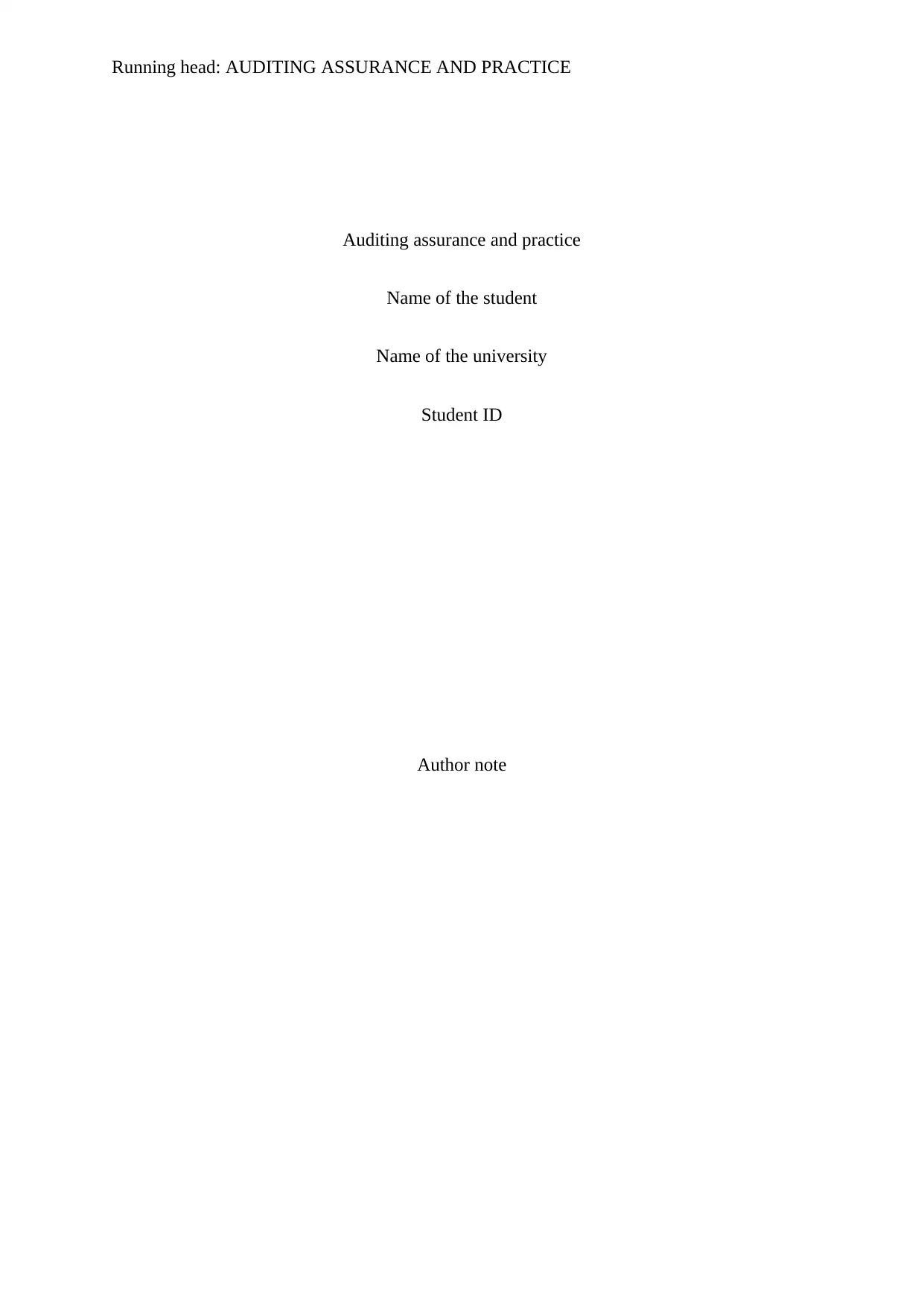
Running head: AUDITING ASSURANCE AND PRACTICE
Auditing assurance and practice
Name of the student
Name of the university
Student ID
Author note
Auditing assurance and practice
Name of the student
Name of the university
Student ID
Author note
Secure Best Marks with AI Grader
Need help grading? Try our AI Grader for instant feedback on your assignments.
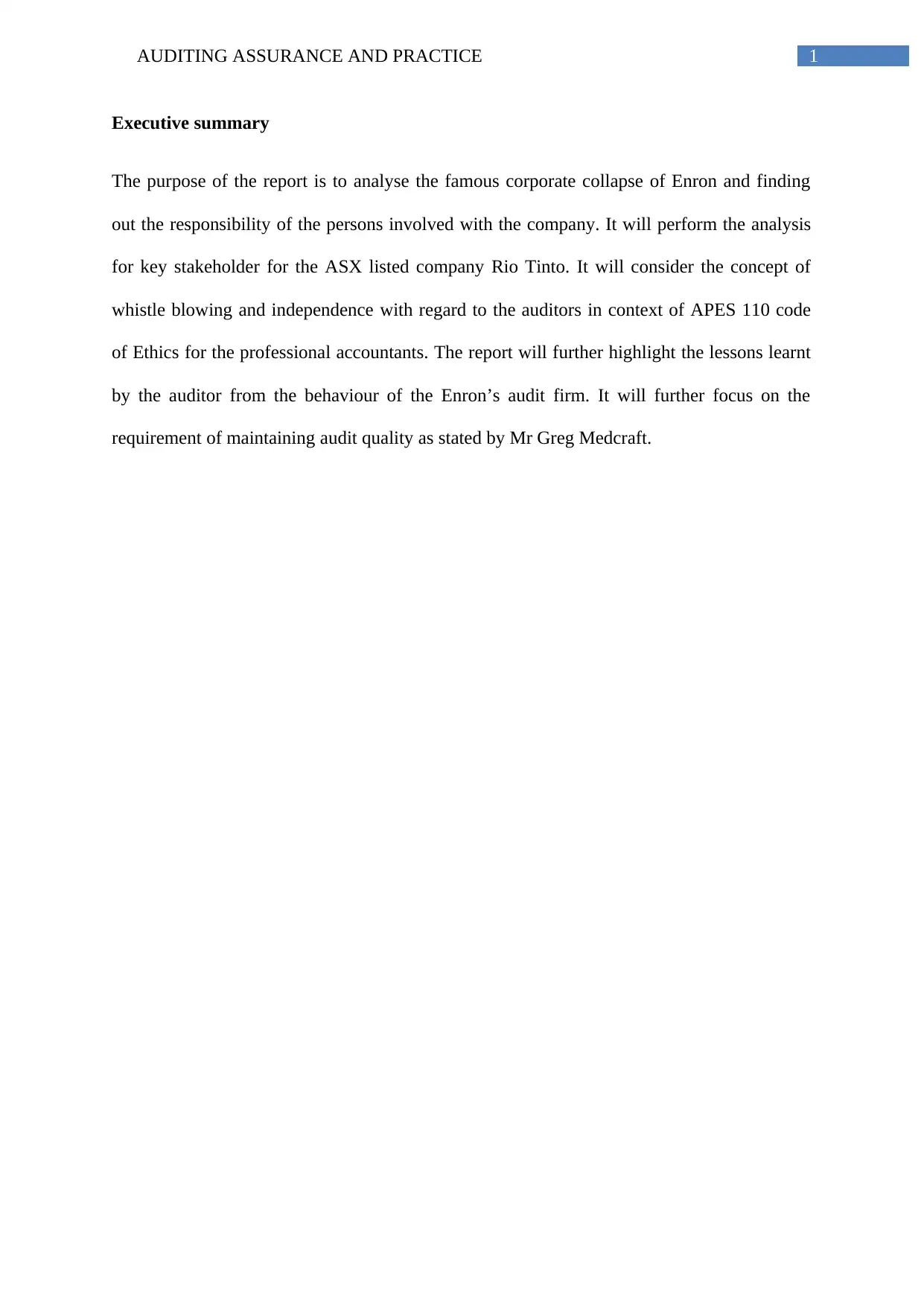
1AUDITING ASSURANCE AND PRACTICE
Executive summary
The purpose of the report is to analyse the famous corporate collapse of Enron and finding
out the responsibility of the persons involved with the company. It will perform the analysis
for key stakeholder for the ASX listed company Rio Tinto. It will consider the concept of
whistle blowing and independence with regard to the auditors in context of APES 110 code
of Ethics for the professional accountants. The report will further highlight the lessons learnt
by the auditor from the behaviour of the Enron’s audit firm. It will further focus on the
requirement of maintaining audit quality as stated by Mr Greg Medcraft.
Executive summary
The purpose of the report is to analyse the famous corporate collapse of Enron and finding
out the responsibility of the persons involved with the company. It will perform the analysis
for key stakeholder for the ASX listed company Rio Tinto. It will consider the concept of
whistle blowing and independence with regard to the auditors in context of APES 110 code
of Ethics for the professional accountants. The report will further highlight the lessons learnt
by the auditor from the behaviour of the Enron’s audit firm. It will further focus on the
requirement of maintaining audit quality as stated by Mr Greg Medcraft.
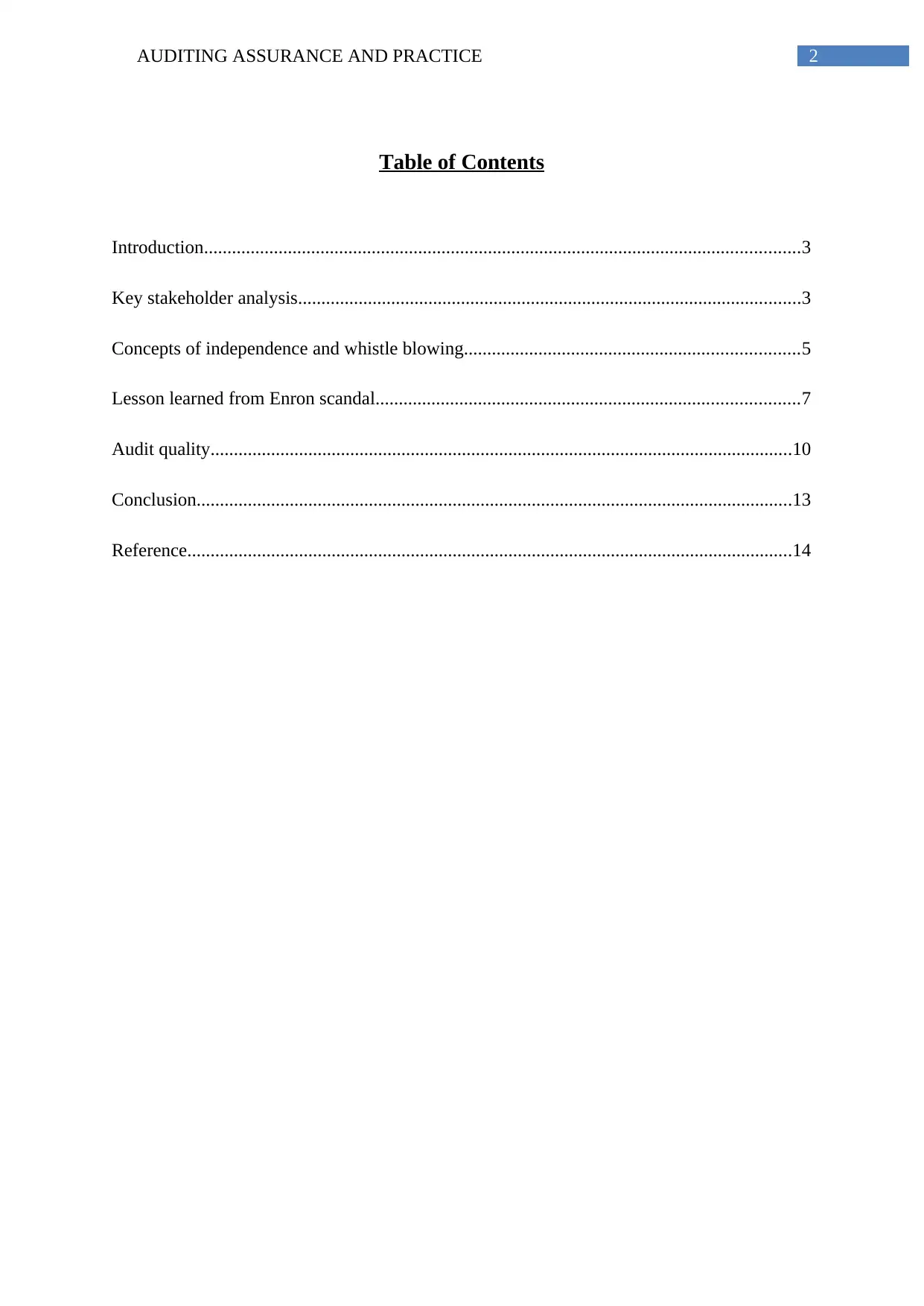
2AUDITING ASSURANCE AND PRACTICE
Table of Contents
Introduction................................................................................................................................3
Key stakeholder analysis............................................................................................................3
Concepts of independence and whistle blowing........................................................................5
Lesson learned from Enron scandal...........................................................................................7
Audit quality.............................................................................................................................10
Conclusion................................................................................................................................13
Reference..................................................................................................................................14
Table of Contents
Introduction................................................................................................................................3
Key stakeholder analysis............................................................................................................3
Concepts of independence and whistle blowing........................................................................5
Lesson learned from Enron scandal...........................................................................................7
Audit quality.............................................................................................................................10
Conclusion................................................................................................................................13
Reference..................................................................................................................................14
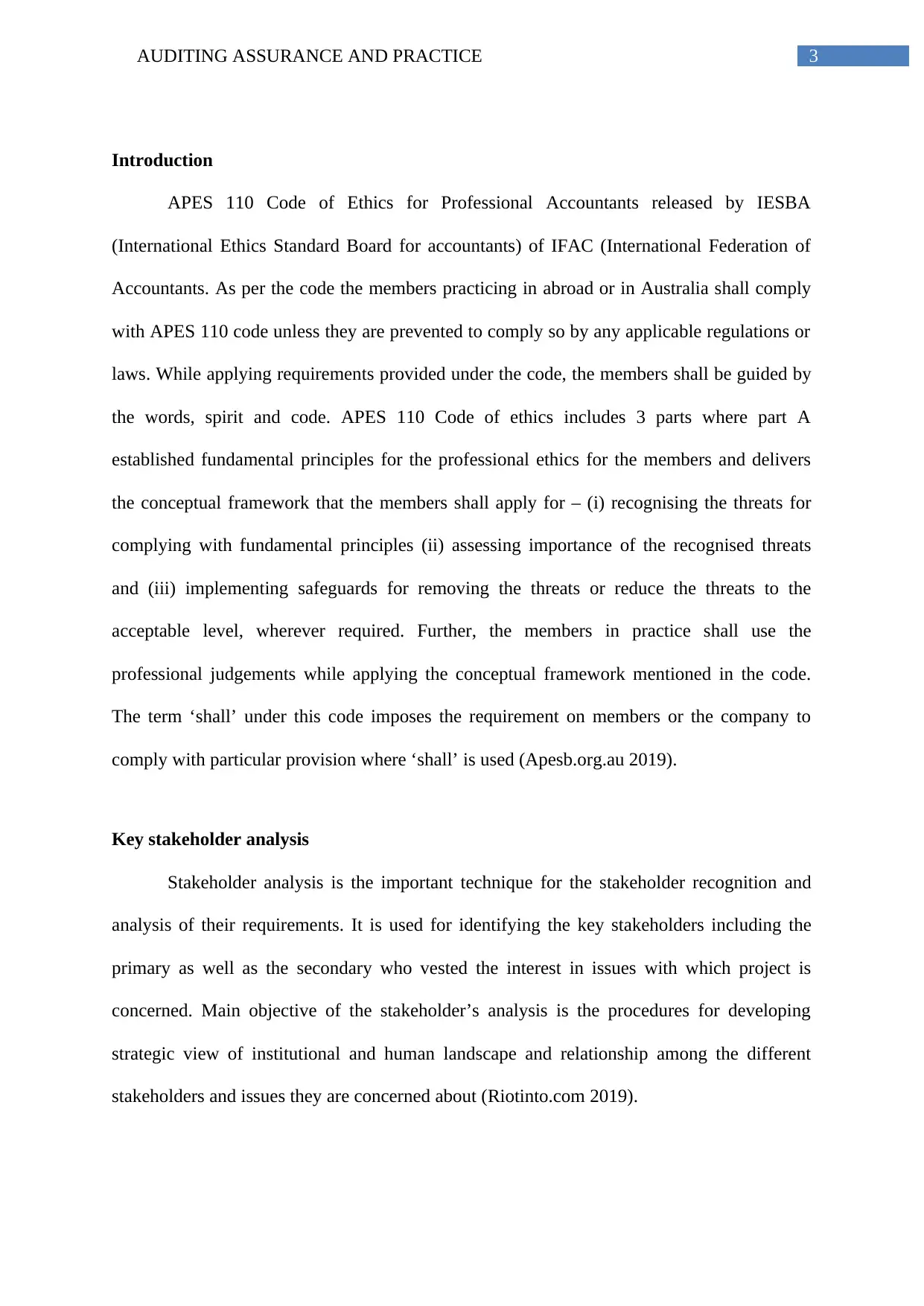
3AUDITING ASSURANCE AND PRACTICE
Introduction
APES 110 Code of Ethics for Professional Accountants released by IESBA
(International Ethics Standard Board for accountants) of IFAC (International Federation of
Accountants. As per the code the members practicing in abroad or in Australia shall comply
with APES 110 code unless they are prevented to comply so by any applicable regulations or
laws. While applying requirements provided under the code, the members shall be guided by
the words, spirit and code. APES 110 Code of ethics includes 3 parts where part A
established fundamental principles for the professional ethics for the members and delivers
the conceptual framework that the members shall apply for – (i) recognising the threats for
complying with fundamental principles (ii) assessing importance of the recognised threats
and (iii) implementing safeguards for removing the threats or reduce the threats to the
acceptable level, wherever required. Further, the members in practice shall use the
professional judgements while applying the conceptual framework mentioned in the code.
The term ‘shall’ under this code imposes the requirement on members or the company to
comply with particular provision where ‘shall’ is used (Apesb.org.au 2019).
Key stakeholder analysis
Stakeholder analysis is the important technique for the stakeholder recognition and
analysis of their requirements. It is used for identifying the key stakeholders including the
primary as well as the secondary who vested the interest in issues with which project is
concerned. Main objective of the stakeholder’s analysis is the procedures for developing
strategic view of institutional and human landscape and relationship among the different
stakeholders and issues they are concerned about (Riotinto.com 2019).
Introduction
APES 110 Code of Ethics for Professional Accountants released by IESBA
(International Ethics Standard Board for accountants) of IFAC (International Federation of
Accountants. As per the code the members practicing in abroad or in Australia shall comply
with APES 110 code unless they are prevented to comply so by any applicable regulations or
laws. While applying requirements provided under the code, the members shall be guided by
the words, spirit and code. APES 110 Code of ethics includes 3 parts where part A
established fundamental principles for the professional ethics for the members and delivers
the conceptual framework that the members shall apply for – (i) recognising the threats for
complying with fundamental principles (ii) assessing importance of the recognised threats
and (iii) implementing safeguards for removing the threats or reduce the threats to the
acceptable level, wherever required. Further, the members in practice shall use the
professional judgements while applying the conceptual framework mentioned in the code.
The term ‘shall’ under this code imposes the requirement on members or the company to
comply with particular provision where ‘shall’ is used (Apesb.org.au 2019).
Key stakeholder analysis
Stakeholder analysis is the important technique for the stakeholder recognition and
analysis of their requirements. It is used for identifying the key stakeholders including the
primary as well as the secondary who vested the interest in issues with which project is
concerned. Main objective of the stakeholder’s analysis is the procedures for developing
strategic view of institutional and human landscape and relationship among the different
stakeholders and issues they are concerned about (Riotinto.com 2019).
Secure Best Marks with AI Grader
Need help grading? Try our AI Grader for instant feedback on your assignments.
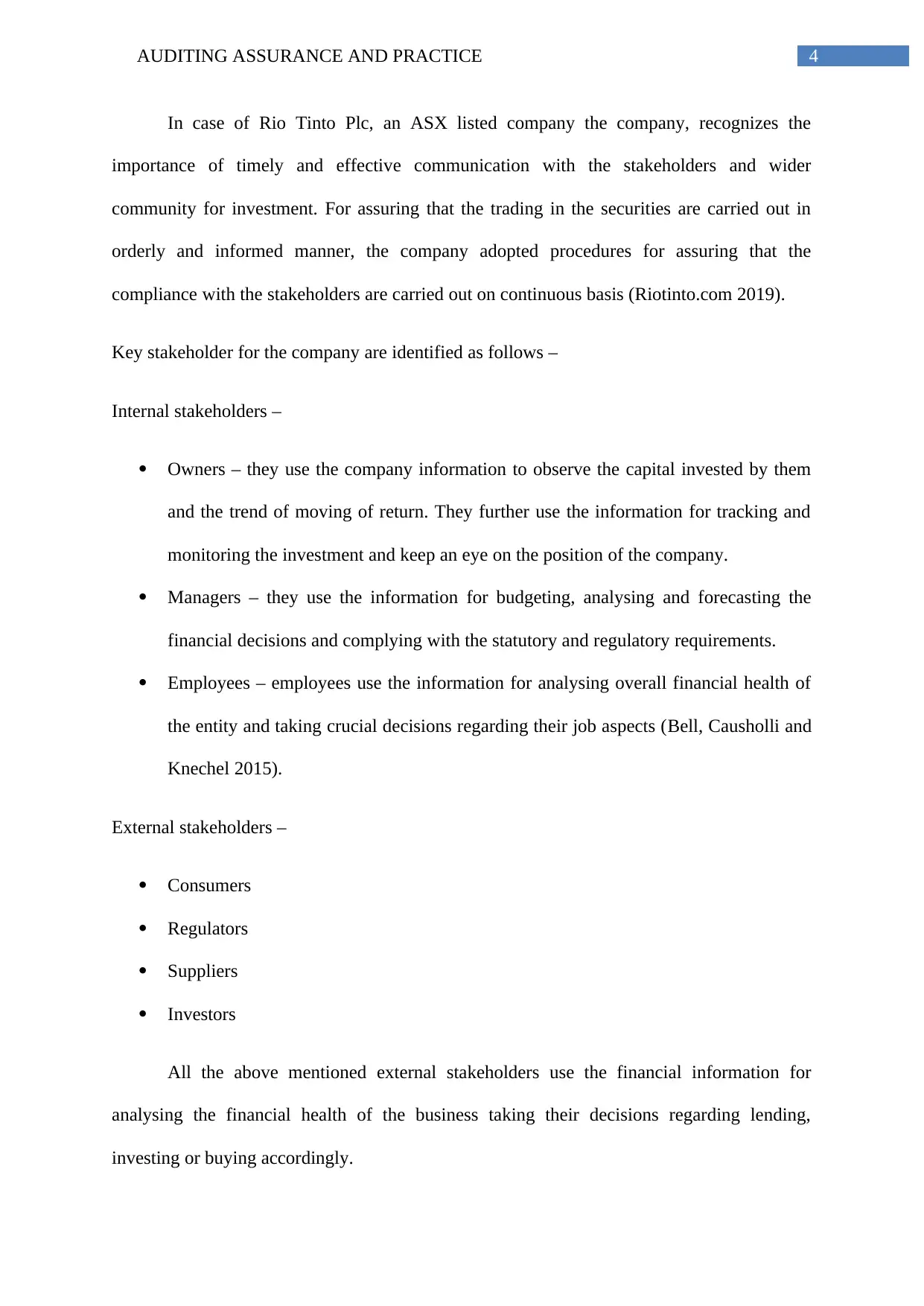
4AUDITING ASSURANCE AND PRACTICE
In case of Rio Tinto Plc, an ASX listed company the company, recognizes the
importance of timely and effective communication with the stakeholders and wider
community for investment. For assuring that the trading in the securities are carried out in
orderly and informed manner, the company adopted procedures for assuring that the
compliance with the stakeholders are carried out on continuous basis (Riotinto.com 2019).
Key stakeholder for the company are identified as follows –
Internal stakeholders –
Owners – they use the company information to observe the capital invested by them
and the trend of moving of return. They further use the information for tracking and
monitoring the investment and keep an eye on the position of the company.
Managers – they use the information for budgeting, analysing and forecasting the
financial decisions and complying with the statutory and regulatory requirements.
Employees – employees use the information for analysing overall financial health of
the entity and taking crucial decisions regarding their job aspects (Bell, Causholli and
Knechel 2015).
External stakeholders –
Consumers
Regulators
Suppliers
Investors
All the above mentioned external stakeholders use the financial information for
analysing the financial health of the business taking their decisions regarding lending,
investing or buying accordingly.
In case of Rio Tinto Plc, an ASX listed company the company, recognizes the
importance of timely and effective communication with the stakeholders and wider
community for investment. For assuring that the trading in the securities are carried out in
orderly and informed manner, the company adopted procedures for assuring that the
compliance with the stakeholders are carried out on continuous basis (Riotinto.com 2019).
Key stakeholder for the company are identified as follows –
Internal stakeholders –
Owners – they use the company information to observe the capital invested by them
and the trend of moving of return. They further use the information for tracking and
monitoring the investment and keep an eye on the position of the company.
Managers – they use the information for budgeting, analysing and forecasting the
financial decisions and complying with the statutory and regulatory requirements.
Employees – employees use the information for analysing overall financial health of
the entity and taking crucial decisions regarding their job aspects (Bell, Causholli and
Knechel 2015).
External stakeholders –
Consumers
Regulators
Suppliers
Investors
All the above mentioned external stakeholders use the financial information for
analysing the financial health of the business taking their decisions regarding lending,
investing or buying accordingly.
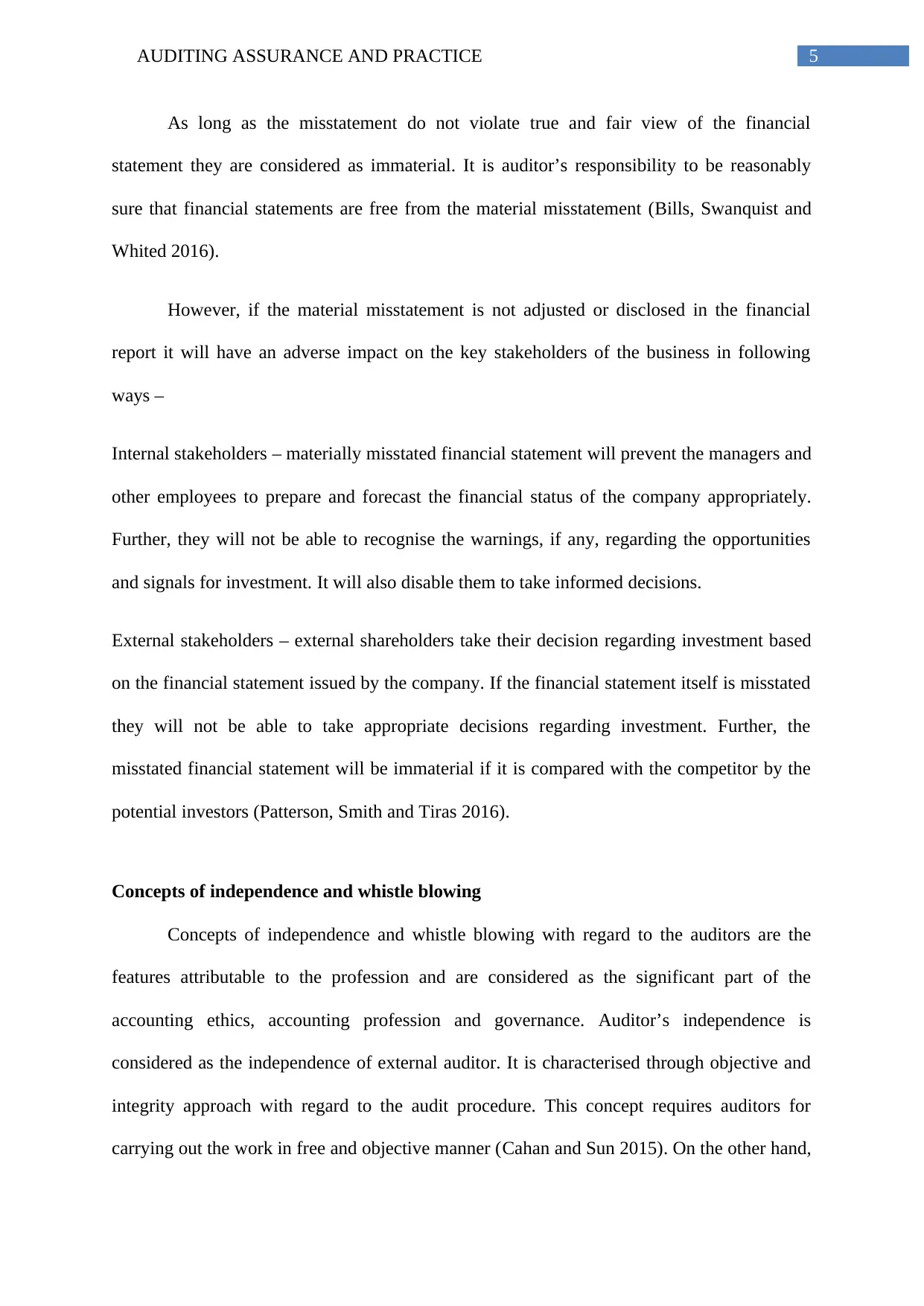
5AUDITING ASSURANCE AND PRACTICE
As long as the misstatement do not violate true and fair view of the financial
statement they are considered as immaterial. It is auditor’s responsibility to be reasonably
sure that financial statements are free from the material misstatement (Bills, Swanquist and
Whited 2016).
However, if the material misstatement is not adjusted or disclosed in the financial
report it will have an adverse impact on the key stakeholders of the business in following
ways –
Internal stakeholders – materially misstated financial statement will prevent the managers and
other employees to prepare and forecast the financial status of the company appropriately.
Further, they will not be able to recognise the warnings, if any, regarding the opportunities
and signals for investment. It will also disable them to take informed decisions.
External stakeholders – external shareholders take their decision regarding investment based
on the financial statement issued by the company. If the financial statement itself is misstated
they will not be able to take appropriate decisions regarding investment. Further, the
misstated financial statement will be immaterial if it is compared with the competitor by the
potential investors (Patterson, Smith and Tiras 2016).
Concepts of independence and whistle blowing
Concepts of independence and whistle blowing with regard to the auditors are the
features attributable to the profession and are considered as the significant part of the
accounting ethics, accounting profession and governance. Auditor’s independence is
considered as the independence of external auditor. It is characterised through objective and
integrity approach with regard to the audit procedure. This concept requires auditors for
carrying out the work in free and objective manner (Cahan and Sun 2015). On the other hand,
As long as the misstatement do not violate true and fair view of the financial
statement they are considered as immaterial. It is auditor’s responsibility to be reasonably
sure that financial statements are free from the material misstatement (Bills, Swanquist and
Whited 2016).
However, if the material misstatement is not adjusted or disclosed in the financial
report it will have an adverse impact on the key stakeholders of the business in following
ways –
Internal stakeholders – materially misstated financial statement will prevent the managers and
other employees to prepare and forecast the financial status of the company appropriately.
Further, they will not be able to recognise the warnings, if any, regarding the opportunities
and signals for investment. It will also disable them to take informed decisions.
External stakeholders – external shareholders take their decision regarding investment based
on the financial statement issued by the company. If the financial statement itself is misstated
they will not be able to take appropriate decisions regarding investment. Further, the
misstated financial statement will be immaterial if it is compared with the competitor by the
potential investors (Patterson, Smith and Tiras 2016).
Concepts of independence and whistle blowing
Concepts of independence and whistle blowing with regard to the auditors are the
features attributable to the profession and are considered as the significant part of the
accounting ethics, accounting profession and governance. Auditor’s independence is
considered as the independence of external auditor. It is characterised through objective and
integrity approach with regard to the audit procedure. This concept requires auditors for
carrying out the work in free and objective manner (Cahan and Sun 2015). On the other hand,
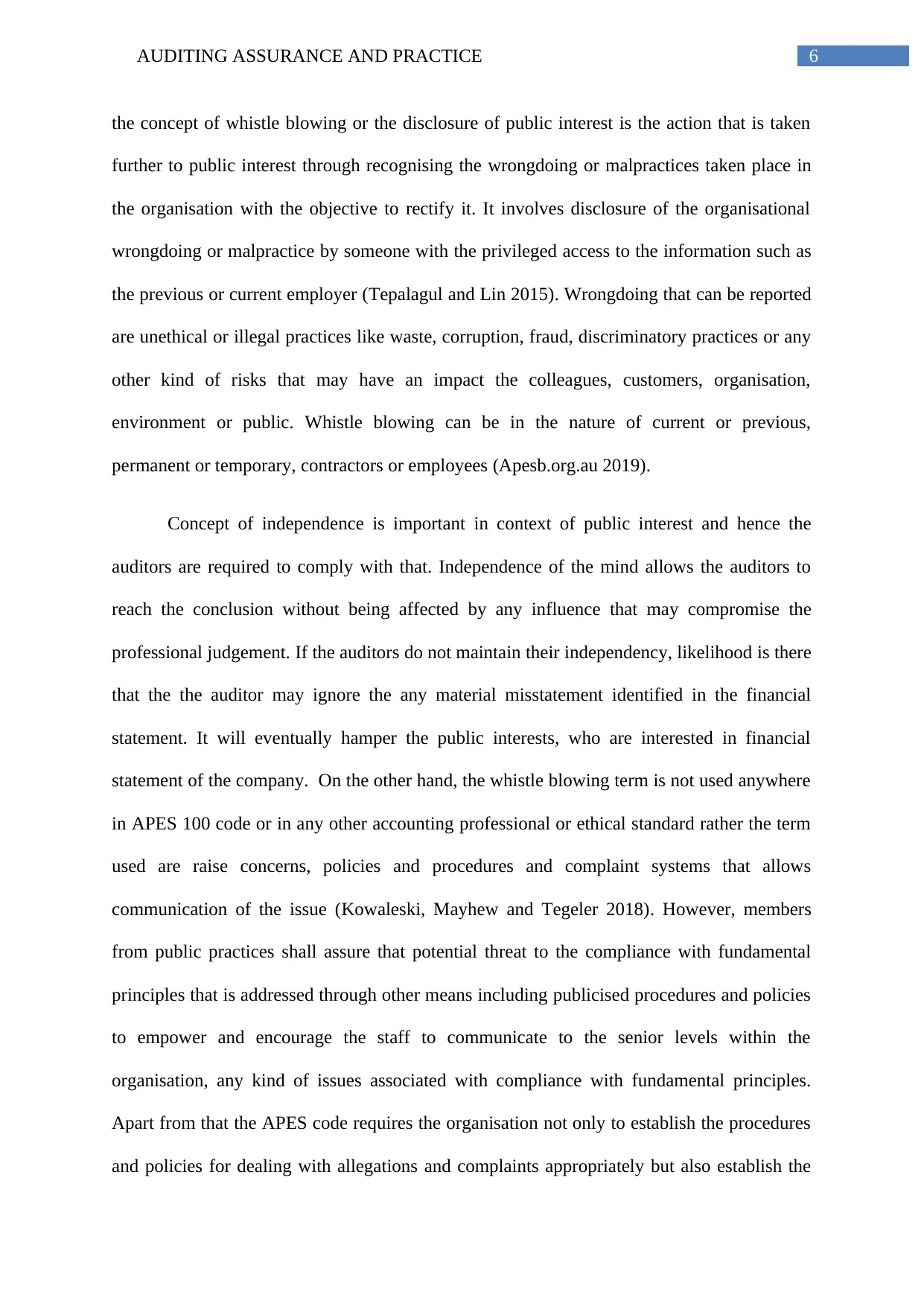
6AUDITING ASSURANCE AND PRACTICE
the concept of whistle blowing or the disclosure of public interest is the action that is taken
further to public interest through recognising the wrongdoing or malpractices taken place in
the organisation with the objective to rectify it. It involves disclosure of the organisational
wrongdoing or malpractice by someone with the privileged access to the information such as
the previous or current employer (Tepalagul and Lin 2015). Wrongdoing that can be reported
are unethical or illegal practices like waste, corruption, fraud, discriminatory practices or any
other kind of risks that may have an impact the colleagues, customers, organisation,
environment or public. Whistle blowing can be in the nature of current or previous,
permanent or temporary, contractors or employees (Apesb.org.au 2019).
Concept of independence is important in context of public interest and hence the
auditors are required to comply with that. Independence of the mind allows the auditors to
reach the conclusion without being affected by any influence that may compromise the
professional judgement. If the auditors do not maintain their independency, likelihood is there
that the the auditor may ignore the any material misstatement identified in the financial
statement. It will eventually hamper the public interests, who are interested in financial
statement of the company. On the other hand, the whistle blowing term is not used anywhere
in APES 100 code or in any other accounting professional or ethical standard rather the term
used are raise concerns, policies and procedures and complaint systems that allows
communication of the issue (Kowaleski, Mayhew and Tegeler 2018). However, members
from public practices shall assure that potential threat to the compliance with fundamental
principles that is addressed through other means including publicised procedures and policies
to empower and encourage the staff to communicate to the senior levels within the
organisation, any kind of issues associated with compliance with fundamental principles.
Apart from that the APES code requires the organisation not only to establish the procedures
and policies for dealing with allegations and complaints appropriately but also establish the
the concept of whistle blowing or the disclosure of public interest is the action that is taken
further to public interest through recognising the wrongdoing or malpractices taken place in
the organisation with the objective to rectify it. It involves disclosure of the organisational
wrongdoing or malpractice by someone with the privileged access to the information such as
the previous or current employer (Tepalagul and Lin 2015). Wrongdoing that can be reported
are unethical or illegal practices like waste, corruption, fraud, discriminatory practices or any
other kind of risks that may have an impact the colleagues, customers, organisation,
environment or public. Whistle blowing can be in the nature of current or previous,
permanent or temporary, contractors or employees (Apesb.org.au 2019).
Concept of independence is important in context of public interest and hence the
auditors are required to comply with that. Independence of the mind allows the auditors to
reach the conclusion without being affected by any influence that may compromise the
professional judgement. If the auditors do not maintain their independency, likelihood is there
that the the auditor may ignore the any material misstatement identified in the financial
statement. It will eventually hamper the public interests, who are interested in financial
statement of the company. On the other hand, the whistle blowing term is not used anywhere
in APES 100 code or in any other accounting professional or ethical standard rather the term
used are raise concerns, policies and procedures and complaint systems that allows
communication of the issue (Kowaleski, Mayhew and Tegeler 2018). However, members
from public practices shall assure that potential threat to the compliance with fundamental
principles that is addressed through other means including publicised procedures and policies
to empower and encourage the staff to communicate to the senior levels within the
organisation, any kind of issues associated with compliance with fundamental principles.
Apart from that the APES code requires the organisation not only to establish the procedures
and policies for dealing with allegations and complaints appropriately but also establish the
Paraphrase This Document
Need a fresh take? Get an instant paraphrase of this document with our AI Paraphraser
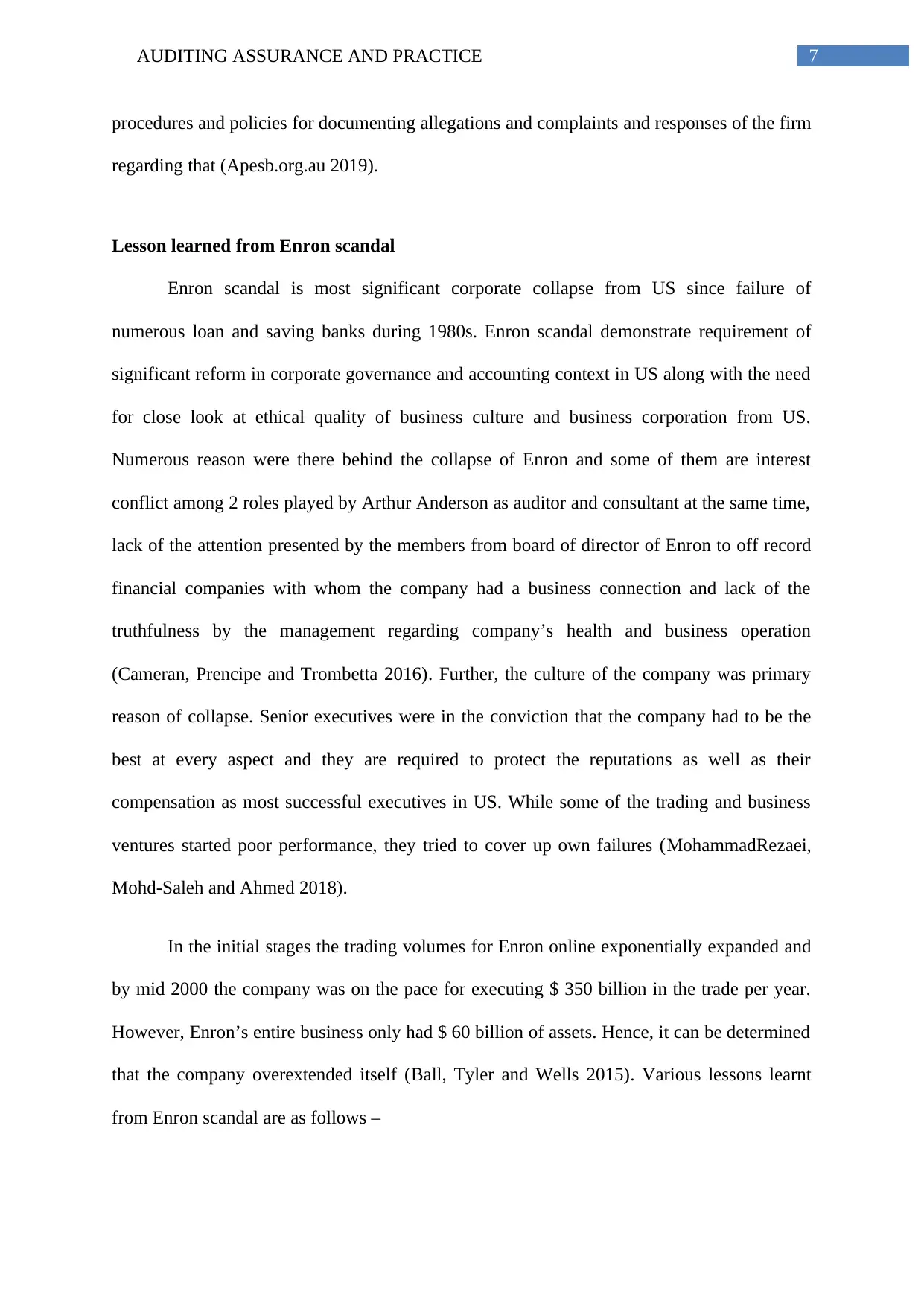
7AUDITING ASSURANCE AND PRACTICE
procedures and policies for documenting allegations and complaints and responses of the firm
regarding that (Apesb.org.au 2019).
Lesson learned from Enron scandal
Enron scandal is most significant corporate collapse from US since failure of
numerous loan and saving banks during 1980s. Enron scandal demonstrate requirement of
significant reform in corporate governance and accounting context in US along with the need
for close look at ethical quality of business culture and business corporation from US.
Numerous reason were there behind the collapse of Enron and some of them are interest
conflict among 2 roles played by Arthur Anderson as auditor and consultant at the same time,
lack of the attention presented by the members from board of director of Enron to off record
financial companies with whom the company had a business connection and lack of the
truthfulness by the management regarding company’s health and business operation
(Cameran, Prencipe and Trombetta 2016). Further, the culture of the company was primary
reason of collapse. Senior executives were in the conviction that the company had to be the
best at every aspect and they are required to protect the reputations as well as their
compensation as most successful executives in US. While some of the trading and business
ventures started poor performance, they tried to cover up own failures (MohammadRezaei,
Mohd-Saleh and Ahmed 2018).
In the initial stages the trading volumes for Enron online exponentially expanded and
by mid 2000 the company was on the pace for executing $ 350 billion in the trade per year.
However, Enron’s entire business only had $ 60 billion of assets. Hence, it can be determined
that the company overextended itself (Ball, Tyler and Wells 2015). Various lessons learnt
from Enron scandal are as follows –
procedures and policies for documenting allegations and complaints and responses of the firm
regarding that (Apesb.org.au 2019).
Lesson learned from Enron scandal
Enron scandal is most significant corporate collapse from US since failure of
numerous loan and saving banks during 1980s. Enron scandal demonstrate requirement of
significant reform in corporate governance and accounting context in US along with the need
for close look at ethical quality of business culture and business corporation from US.
Numerous reason were there behind the collapse of Enron and some of them are interest
conflict among 2 roles played by Arthur Anderson as auditor and consultant at the same time,
lack of the attention presented by the members from board of director of Enron to off record
financial companies with whom the company had a business connection and lack of the
truthfulness by the management regarding company’s health and business operation
(Cameran, Prencipe and Trombetta 2016). Further, the culture of the company was primary
reason of collapse. Senior executives were in the conviction that the company had to be the
best at every aspect and they are required to protect the reputations as well as their
compensation as most successful executives in US. While some of the trading and business
ventures started poor performance, they tried to cover up own failures (MohammadRezaei,
Mohd-Saleh and Ahmed 2018).
In the initial stages the trading volumes for Enron online exponentially expanded and
by mid 2000 the company was on the pace for executing $ 350 billion in the trade per year.
However, Enron’s entire business only had $ 60 billion of assets. Hence, it can be determined
that the company overextended itself (Ball, Tyler and Wells 2015). Various lessons learnt
from Enron scandal are as follows –
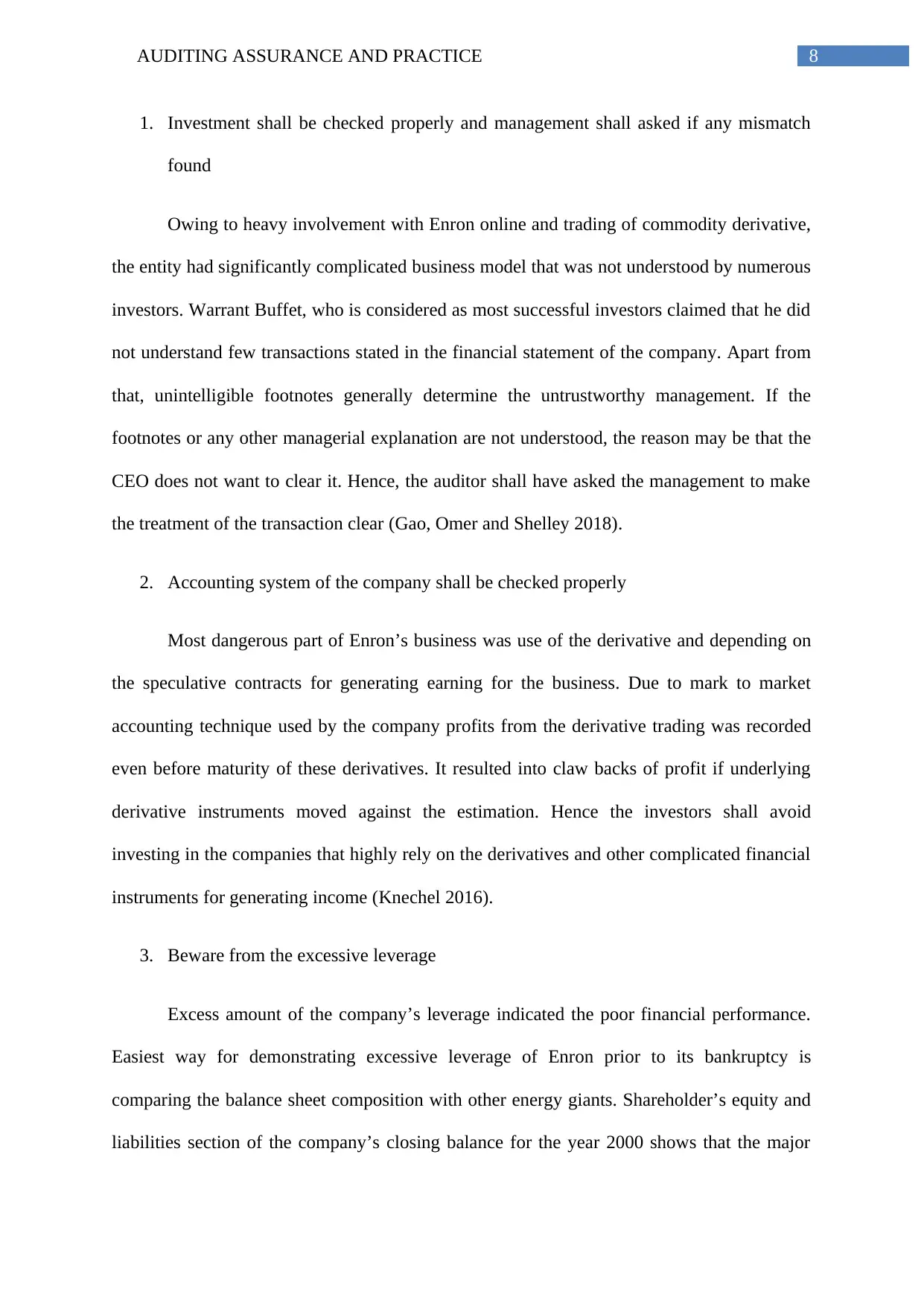
8AUDITING ASSURANCE AND PRACTICE
1. Investment shall be checked properly and management shall asked if any mismatch
found
Owing to heavy involvement with Enron online and trading of commodity derivative,
the entity had significantly complicated business model that was not understood by numerous
investors. Warrant Buffet, who is considered as most successful investors claimed that he did
not understand few transactions stated in the financial statement of the company. Apart from
that, unintelligible footnotes generally determine the untrustworthy management. If the
footnotes or any other managerial explanation are not understood, the reason may be that the
CEO does not want to clear it. Hence, the auditor shall have asked the management to make
the treatment of the transaction clear (Gao, Omer and Shelley 2018).
2. Accounting system of the company shall be checked properly
Most dangerous part of Enron’s business was use of the derivative and depending on
the speculative contracts for generating earning for the business. Due to mark to market
accounting technique used by the company profits from the derivative trading was recorded
even before maturity of these derivatives. It resulted into claw backs of profit if underlying
derivative instruments moved against the estimation. Hence the investors shall avoid
investing in the companies that highly rely on the derivatives and other complicated financial
instruments for generating income (Knechel 2016).
3. Beware from the excessive leverage
Excess amount of the company’s leverage indicated the poor financial performance.
Easiest way for demonstrating excessive leverage of Enron prior to its bankruptcy is
comparing the balance sheet composition with other energy giants. Shareholder’s equity and
liabilities section of the company’s closing balance for the year 2000 shows that the major
1. Investment shall be checked properly and management shall asked if any mismatch
found
Owing to heavy involvement with Enron online and trading of commodity derivative,
the entity had significantly complicated business model that was not understood by numerous
investors. Warrant Buffet, who is considered as most successful investors claimed that he did
not understand few transactions stated in the financial statement of the company. Apart from
that, unintelligible footnotes generally determine the untrustworthy management. If the
footnotes or any other managerial explanation are not understood, the reason may be that the
CEO does not want to clear it. Hence, the auditor shall have asked the management to make
the treatment of the transaction clear (Gao, Omer and Shelley 2018).
2. Accounting system of the company shall be checked properly
Most dangerous part of Enron’s business was use of the derivative and depending on
the speculative contracts for generating earning for the business. Due to mark to market
accounting technique used by the company profits from the derivative trading was recorded
even before maturity of these derivatives. It resulted into claw backs of profit if underlying
derivative instruments moved against the estimation. Hence the investors shall avoid
investing in the companies that highly rely on the derivatives and other complicated financial
instruments for generating income (Knechel 2016).
3. Beware from the excessive leverage
Excess amount of the company’s leverage indicated the poor financial performance.
Easiest way for demonstrating excessive leverage of Enron prior to its bankruptcy is
comparing the balance sheet composition with other energy giants. Shareholder’s equity and
liabilities section of the company’s closing balance for the year 2000 shows that the major
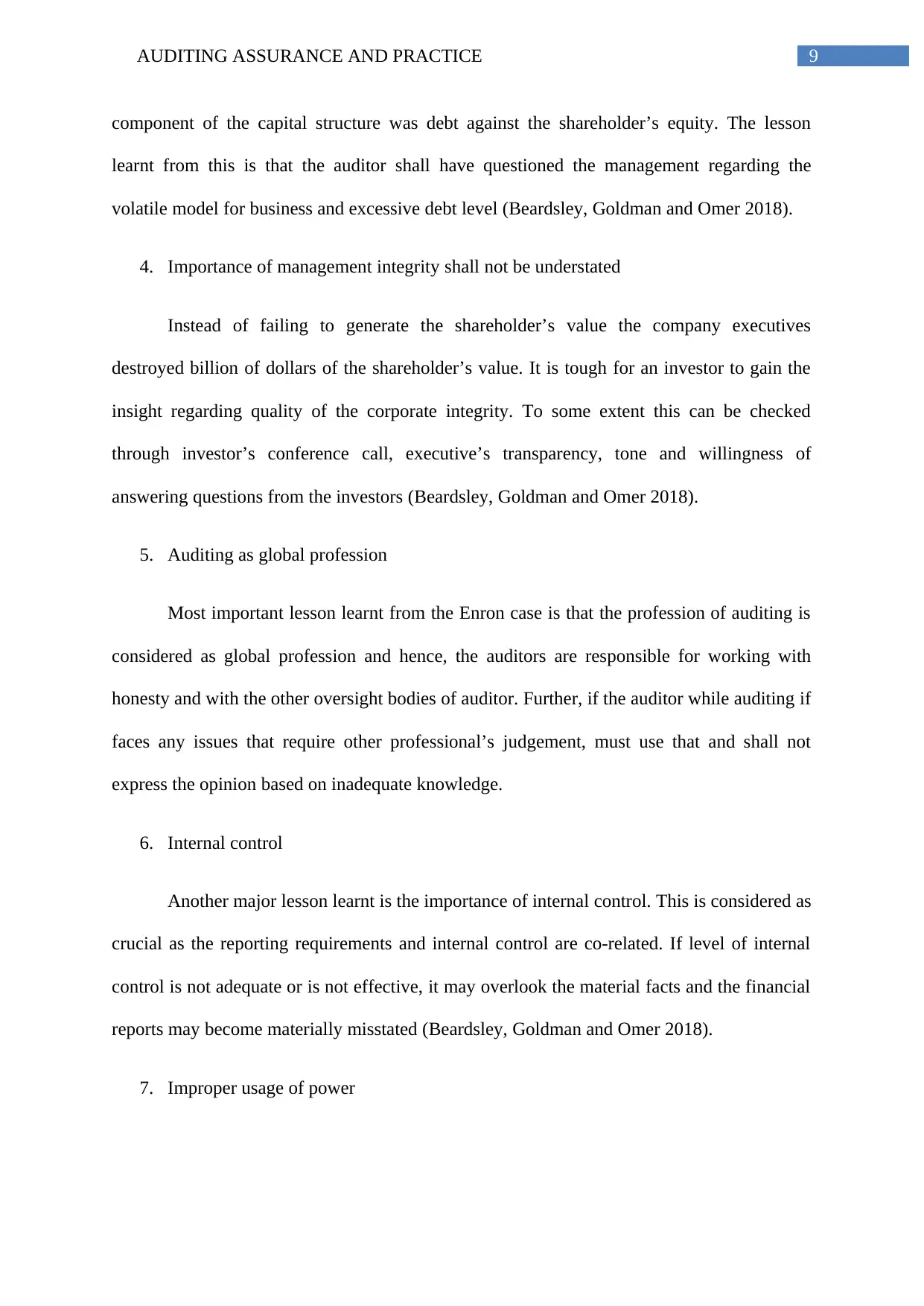
9AUDITING ASSURANCE AND PRACTICE
component of the capital structure was debt against the shareholder’s equity. The lesson
learnt from this is that the auditor shall have questioned the management regarding the
volatile model for business and excessive debt level (Beardsley, Goldman and Omer 2018).
4. Importance of management integrity shall not be understated
Instead of failing to generate the shareholder’s value the company executives
destroyed billion of dollars of the shareholder’s value. It is tough for an investor to gain the
insight regarding quality of the corporate integrity. To some extent this can be checked
through investor’s conference call, executive’s transparency, tone and willingness of
answering questions from the investors (Beardsley, Goldman and Omer 2018).
5. Auditing as global profession
Most important lesson learnt from the Enron case is that the profession of auditing is
considered as global profession and hence, the auditors are responsible for working with
honesty and with the other oversight bodies of auditor. Further, if the auditor while auditing if
faces any issues that require other professional’s judgement, must use that and shall not
express the opinion based on inadequate knowledge.
6. Internal control
Another major lesson learnt is the importance of internal control. This is considered as
crucial as the reporting requirements and internal control are co-related. If level of internal
control is not adequate or is not effective, it may overlook the material facts and the financial
reports may become materially misstated (Beardsley, Goldman and Omer 2018).
7. Improper usage of power
component of the capital structure was debt against the shareholder’s equity. The lesson
learnt from this is that the auditor shall have questioned the management regarding the
volatile model for business and excessive debt level (Beardsley, Goldman and Omer 2018).
4. Importance of management integrity shall not be understated
Instead of failing to generate the shareholder’s value the company executives
destroyed billion of dollars of the shareholder’s value. It is tough for an investor to gain the
insight regarding quality of the corporate integrity. To some extent this can be checked
through investor’s conference call, executive’s transparency, tone and willingness of
answering questions from the investors (Beardsley, Goldman and Omer 2018).
5. Auditing as global profession
Most important lesson learnt from the Enron case is that the profession of auditing is
considered as global profession and hence, the auditors are responsible for working with
honesty and with the other oversight bodies of auditor. Further, if the auditor while auditing if
faces any issues that require other professional’s judgement, must use that and shall not
express the opinion based on inadequate knowledge.
6. Internal control
Another major lesson learnt is the importance of internal control. This is considered as
crucial as the reporting requirements and internal control are co-related. If level of internal
control is not adequate or is not effective, it may overlook the material facts and the financial
reports may become materially misstated (Beardsley, Goldman and Omer 2018).
7. Improper usage of power
Secure Best Marks with AI Grader
Need help grading? Try our AI Grader for instant feedback on your assignments.
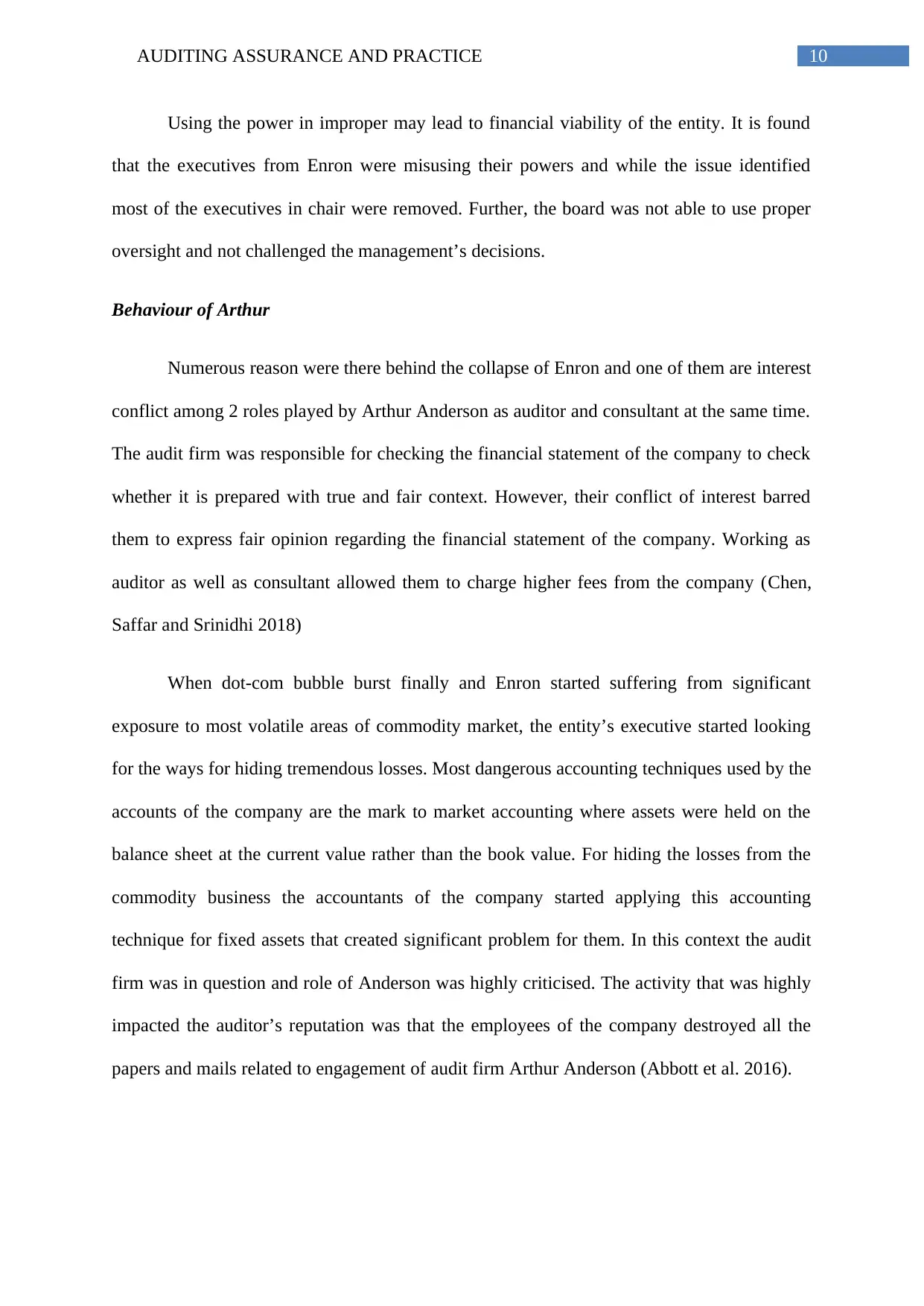
10AUDITING ASSURANCE AND PRACTICE
Using the power in improper may lead to financial viability of the entity. It is found
that the executives from Enron were misusing their powers and while the issue identified
most of the executives in chair were removed. Further, the board was not able to use proper
oversight and not challenged the management’s decisions.
Behaviour of Arthur
Numerous reason were there behind the collapse of Enron and one of them are interest
conflict among 2 roles played by Arthur Anderson as auditor and consultant at the same time.
The audit firm was responsible for checking the financial statement of the company to check
whether it is prepared with true and fair context. However, their conflict of interest barred
them to express fair opinion regarding the financial statement of the company. Working as
auditor as well as consultant allowed them to charge higher fees from the company (Chen,
Saffar and Srinidhi 2018)
When dot-com bubble burst finally and Enron started suffering from significant
exposure to most volatile areas of commodity market, the entity’s executive started looking
for the ways for hiding tremendous losses. Most dangerous accounting techniques used by the
accounts of the company are the mark to market accounting where assets were held on the
balance sheet at the current value rather than the book value. For hiding the losses from the
commodity business the accountants of the company started applying this accounting
technique for fixed assets that created significant problem for them. In this context the audit
firm was in question and role of Anderson was highly criticised. The activity that was highly
impacted the auditor’s reputation was that the employees of the company destroyed all the
papers and mails related to engagement of audit firm Arthur Anderson (Abbott et al. 2016).
Using the power in improper may lead to financial viability of the entity. It is found
that the executives from Enron were misusing their powers and while the issue identified
most of the executives in chair were removed. Further, the board was not able to use proper
oversight and not challenged the management’s decisions.
Behaviour of Arthur
Numerous reason were there behind the collapse of Enron and one of them are interest
conflict among 2 roles played by Arthur Anderson as auditor and consultant at the same time.
The audit firm was responsible for checking the financial statement of the company to check
whether it is prepared with true and fair context. However, their conflict of interest barred
them to express fair opinion regarding the financial statement of the company. Working as
auditor as well as consultant allowed them to charge higher fees from the company (Chen,
Saffar and Srinidhi 2018)
When dot-com bubble burst finally and Enron started suffering from significant
exposure to most volatile areas of commodity market, the entity’s executive started looking
for the ways for hiding tremendous losses. Most dangerous accounting techniques used by the
accounts of the company are the mark to market accounting where assets were held on the
balance sheet at the current value rather than the book value. For hiding the losses from the
commodity business the accountants of the company started applying this accounting
technique for fixed assets that created significant problem for them. In this context the audit
firm was in question and role of Anderson was highly criticised. The activity that was highly
impacted the auditor’s reputation was that the employees of the company destroyed all the
papers and mails related to engagement of audit firm Arthur Anderson (Abbott et al. 2016).
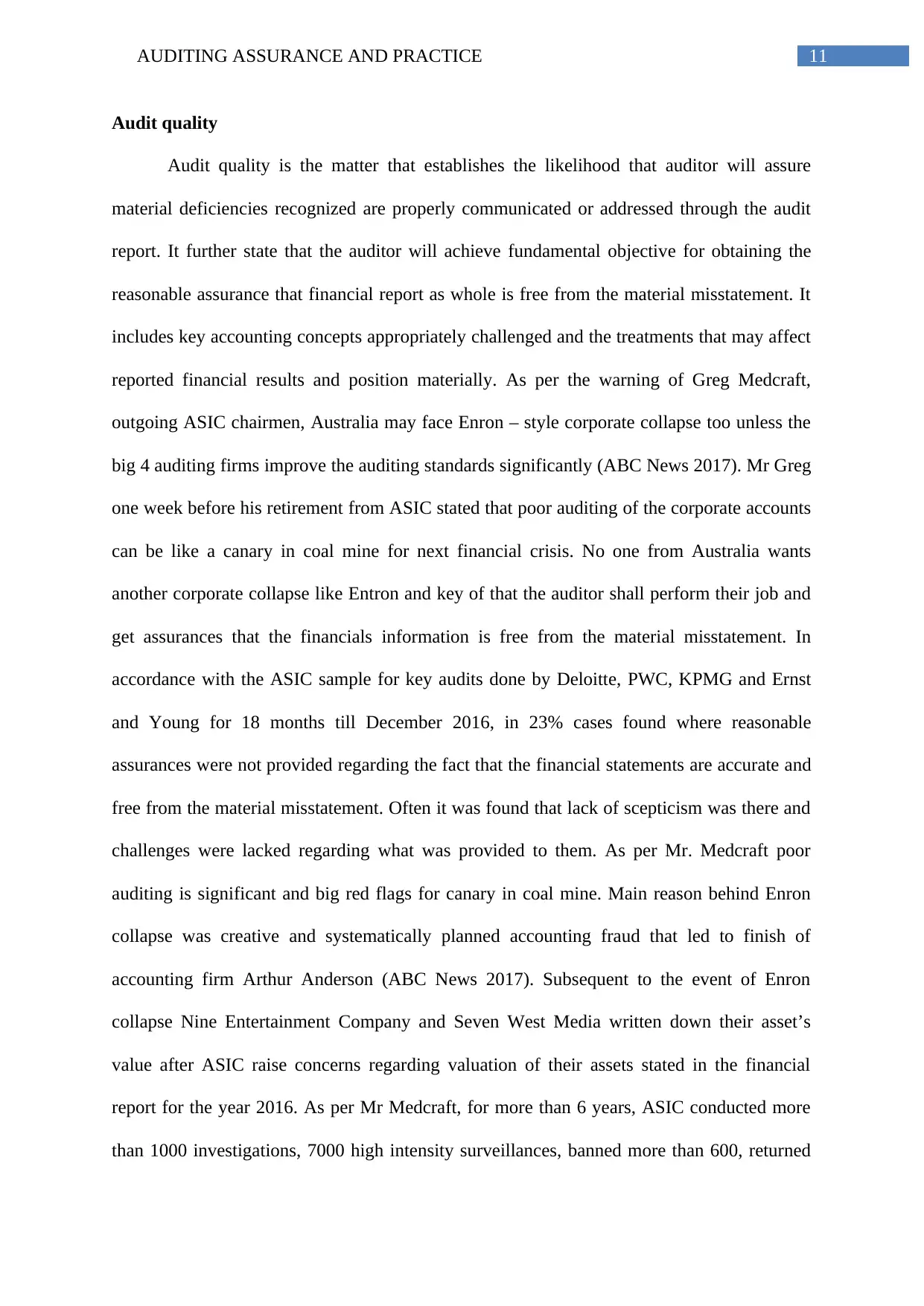
11AUDITING ASSURANCE AND PRACTICE
Audit quality
Audit quality is the matter that establishes the likelihood that auditor will assure
material deficiencies recognized are properly communicated or addressed through the audit
report. It further state that the auditor will achieve fundamental objective for obtaining the
reasonable assurance that financial report as whole is free from the material misstatement. It
includes key accounting concepts appropriately challenged and the treatments that may affect
reported financial results and position materially. As per the warning of Greg Medcraft,
outgoing ASIC chairmen, Australia may face Enron – style corporate collapse too unless the
big 4 auditing firms improve the auditing standards significantly (ABC News 2017). Mr Greg
one week before his retirement from ASIC stated that poor auditing of the corporate accounts
can be like a canary in coal mine for next financial crisis. No one from Australia wants
another corporate collapse like Entron and key of that the auditor shall perform their job and
get assurances that the financials information is free from the material misstatement. In
accordance with the ASIC sample for key audits done by Deloitte, PWC, KPMG and Ernst
and Young for 18 months till December 2016, in 23% cases found where reasonable
assurances were not provided regarding the fact that the financial statements are accurate and
free from the material misstatement. Often it was found that lack of scepticism was there and
challenges were lacked regarding what was provided to them. As per Mr. Medcraft poor
auditing is significant and big red flags for canary in coal mine. Main reason behind Enron
collapse was creative and systematically planned accounting fraud that led to finish of
accounting firm Arthur Anderson (ABC News 2017). Subsequent to the event of Enron
collapse Nine Entertainment Company and Seven West Media written down their asset’s
value after ASIC raise concerns regarding valuation of their assets stated in the financial
report for the year 2016. As per Mr Medcraft, for more than 6 years, ASIC conducted more
than 1000 investigations, 7000 high intensity surveillances, banned more than 600, returned
Audit quality
Audit quality is the matter that establishes the likelihood that auditor will assure
material deficiencies recognized are properly communicated or addressed through the audit
report. It further state that the auditor will achieve fundamental objective for obtaining the
reasonable assurance that financial report as whole is free from the material misstatement. It
includes key accounting concepts appropriately challenged and the treatments that may affect
reported financial results and position materially. As per the warning of Greg Medcraft,
outgoing ASIC chairmen, Australia may face Enron – style corporate collapse too unless the
big 4 auditing firms improve the auditing standards significantly (ABC News 2017). Mr Greg
one week before his retirement from ASIC stated that poor auditing of the corporate accounts
can be like a canary in coal mine for next financial crisis. No one from Australia wants
another corporate collapse like Entron and key of that the auditor shall perform their job and
get assurances that the financials information is free from the material misstatement. In
accordance with the ASIC sample for key audits done by Deloitte, PWC, KPMG and Ernst
and Young for 18 months till December 2016, in 23% cases found where reasonable
assurances were not provided regarding the fact that the financial statements are accurate and
free from the material misstatement. Often it was found that lack of scepticism was there and
challenges were lacked regarding what was provided to them. As per Mr. Medcraft poor
auditing is significant and big red flags for canary in coal mine. Main reason behind Enron
collapse was creative and systematically planned accounting fraud that led to finish of
accounting firm Arthur Anderson (ABC News 2017). Subsequent to the event of Enron
collapse Nine Entertainment Company and Seven West Media written down their asset’s
value after ASIC raise concerns regarding valuation of their assets stated in the financial
report for the year 2016. As per Mr Medcraft, for more than 6 years, ASIC conducted more
than 1000 investigations, 7000 high intensity surveillances, banned more than 600, returned
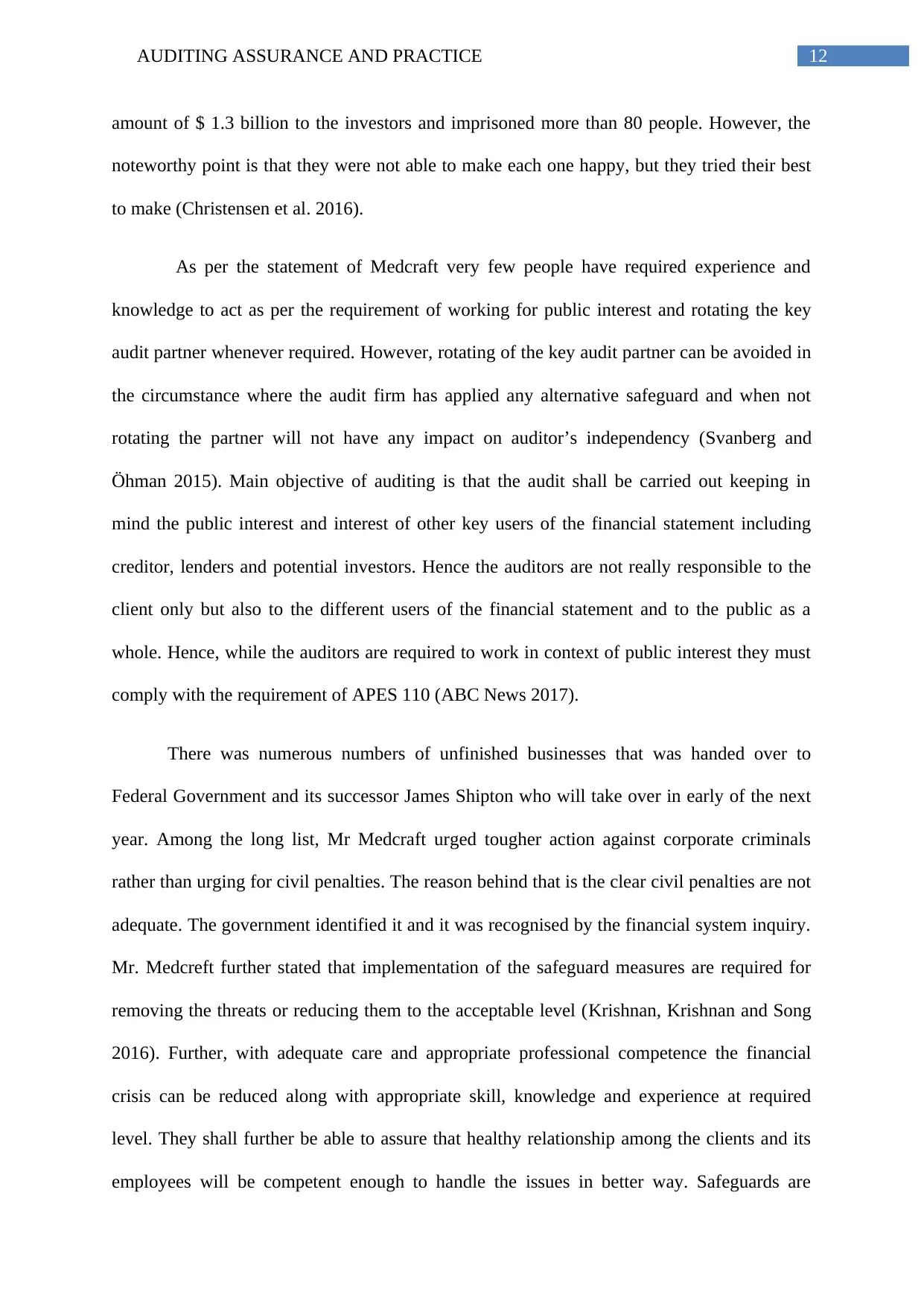
12AUDITING ASSURANCE AND PRACTICE
amount of $ 1.3 billion to the investors and imprisoned more than 80 people. However, the
noteworthy point is that they were not able to make each one happy, but they tried their best
to make (Christensen et al. 2016).
As per the statement of Medcraft very few people have required experience and
knowledge to act as per the requirement of working for public interest and rotating the key
audit partner whenever required. However, rotating of the key audit partner can be avoided in
the circumstance where the audit firm has applied any alternative safeguard and when not
rotating the partner will not have any impact on auditor’s independency (Svanberg and
Öhman 2015). Main objective of auditing is that the audit shall be carried out keeping in
mind the public interest and interest of other key users of the financial statement including
creditor, lenders and potential investors. Hence the auditors are not really responsible to the
client only but also to the different users of the financial statement and to the public as a
whole. Hence, while the auditors are required to work in context of public interest they must
comply with the requirement of APES 110 (ABC News 2017).
There was numerous numbers of unfinished businesses that was handed over to
Federal Government and its successor James Shipton who will take over in early of the next
year. Among the long list, Mr Medcraft urged tougher action against corporate criminals
rather than urging for civil penalties. The reason behind that is the clear civil penalties are not
adequate. The government identified it and it was recognised by the financial system inquiry.
Mr. Medcreft further stated that implementation of the safeguard measures are required for
removing the threats or reducing them to the acceptable level (Krishnan, Krishnan and Song
2016). Further, with adequate care and appropriate professional competence the financial
crisis can be reduced along with appropriate skill, knowledge and experience at required
level. They shall further be able to assure that healthy relationship among the clients and its
employees will be competent enough to handle the issues in better way. Safeguards are
amount of $ 1.3 billion to the investors and imprisoned more than 80 people. However, the
noteworthy point is that they were not able to make each one happy, but they tried their best
to make (Christensen et al. 2016).
As per the statement of Medcraft very few people have required experience and
knowledge to act as per the requirement of working for public interest and rotating the key
audit partner whenever required. However, rotating of the key audit partner can be avoided in
the circumstance where the audit firm has applied any alternative safeguard and when not
rotating the partner will not have any impact on auditor’s independency (Svanberg and
Öhman 2015). Main objective of auditing is that the audit shall be carried out keeping in
mind the public interest and interest of other key users of the financial statement including
creditor, lenders and potential investors. Hence the auditors are not really responsible to the
client only but also to the different users of the financial statement and to the public as a
whole. Hence, while the auditors are required to work in context of public interest they must
comply with the requirement of APES 110 (ABC News 2017).
There was numerous numbers of unfinished businesses that was handed over to
Federal Government and its successor James Shipton who will take over in early of the next
year. Among the long list, Mr Medcraft urged tougher action against corporate criminals
rather than urging for civil penalties. The reason behind that is the clear civil penalties are not
adequate. The government identified it and it was recognised by the financial system inquiry.
Mr. Medcreft further stated that implementation of the safeguard measures are required for
removing the threats or reducing them to the acceptable level (Krishnan, Krishnan and Song
2016). Further, with adequate care and appropriate professional competence the financial
crisis can be reduced along with appropriate skill, knowledge and experience at required
level. They shall further be able to assure that healthy relationship among the clients and its
employees will be competent enough to handle the issues in better way. Safeguards are
Paraphrase This Document
Need a fresh take? Get an instant paraphrase of this document with our AI Paraphraser
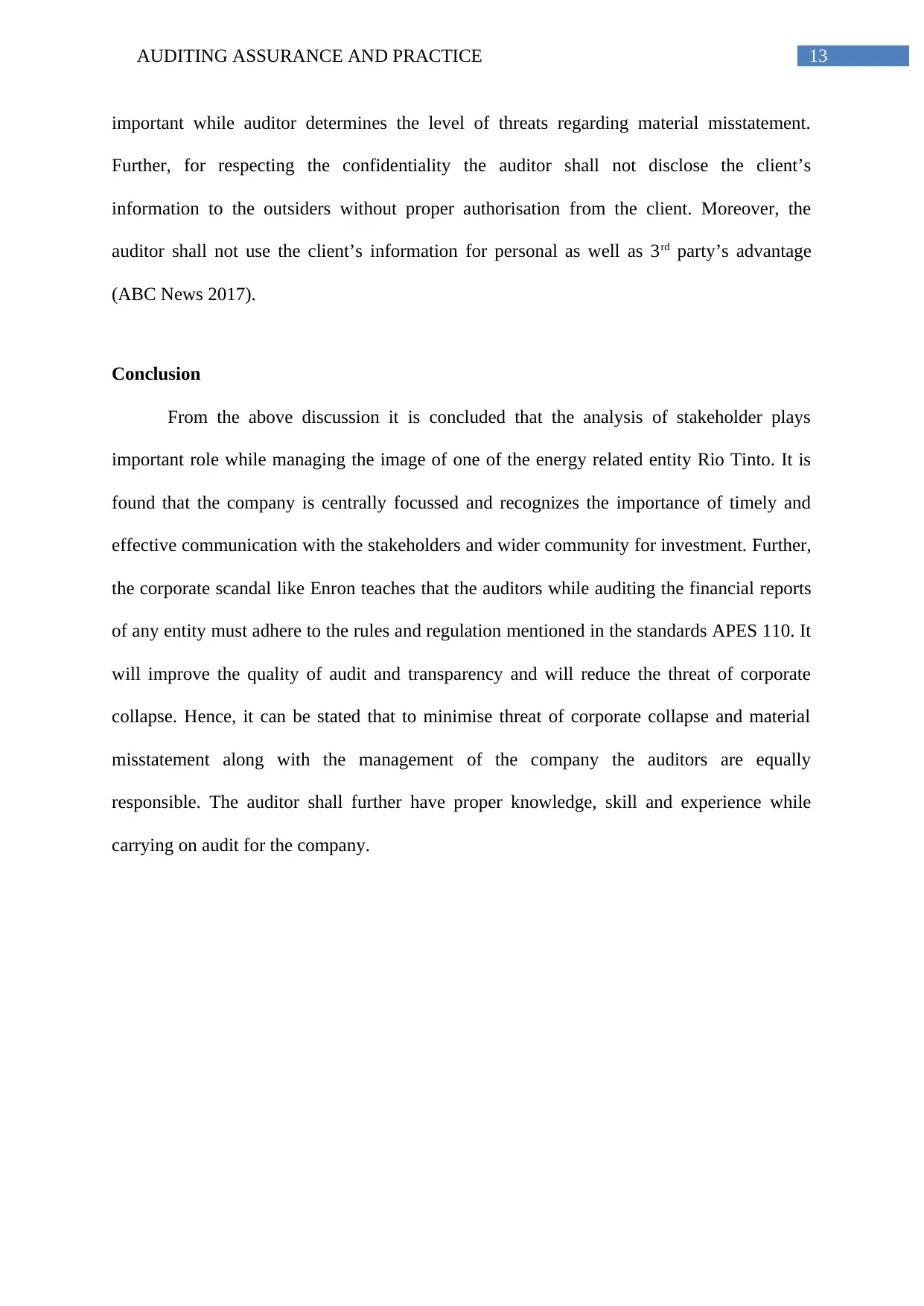
13AUDITING ASSURANCE AND PRACTICE
important while auditor determines the level of threats regarding material misstatement.
Further, for respecting the confidentiality the auditor shall not disclose the client’s
information to the outsiders without proper authorisation from the client. Moreover, the
auditor shall not use the client’s information for personal as well as 3rd party’s advantage
(ABC News 2017).
Conclusion
From the above discussion it is concluded that the analysis of stakeholder plays
important role while managing the image of one of the energy related entity Rio Tinto. It is
found that the company is centrally focussed and recognizes the importance of timely and
effective communication with the stakeholders and wider community for investment. Further,
the corporate scandal like Enron teaches that the auditors while auditing the financial reports
of any entity must adhere to the rules and regulation mentioned in the standards APES 110. It
will improve the quality of audit and transparency and will reduce the threat of corporate
collapse. Hence, it can be stated that to minimise threat of corporate collapse and material
misstatement along with the management of the company the auditors are equally
responsible. The auditor shall further have proper knowledge, skill and experience while
carrying on audit for the company.
important while auditor determines the level of threats regarding material misstatement.
Further, for respecting the confidentiality the auditor shall not disclose the client’s
information to the outsiders without proper authorisation from the client. Moreover, the
auditor shall not use the client’s information for personal as well as 3rd party’s advantage
(ABC News 2017).
Conclusion
From the above discussion it is concluded that the analysis of stakeholder plays
important role while managing the image of one of the energy related entity Rio Tinto. It is
found that the company is centrally focussed and recognizes the importance of timely and
effective communication with the stakeholders and wider community for investment. Further,
the corporate scandal like Enron teaches that the auditors while auditing the financial reports
of any entity must adhere to the rules and regulation mentioned in the standards APES 110. It
will improve the quality of audit and transparency and will reduce the threat of corporate
collapse. Hence, it can be stated that to minimise threat of corporate collapse and material
misstatement along with the management of the company the auditors are equally
responsible. The auditor shall further have proper knowledge, skill and experience while
carrying on audit for the company.
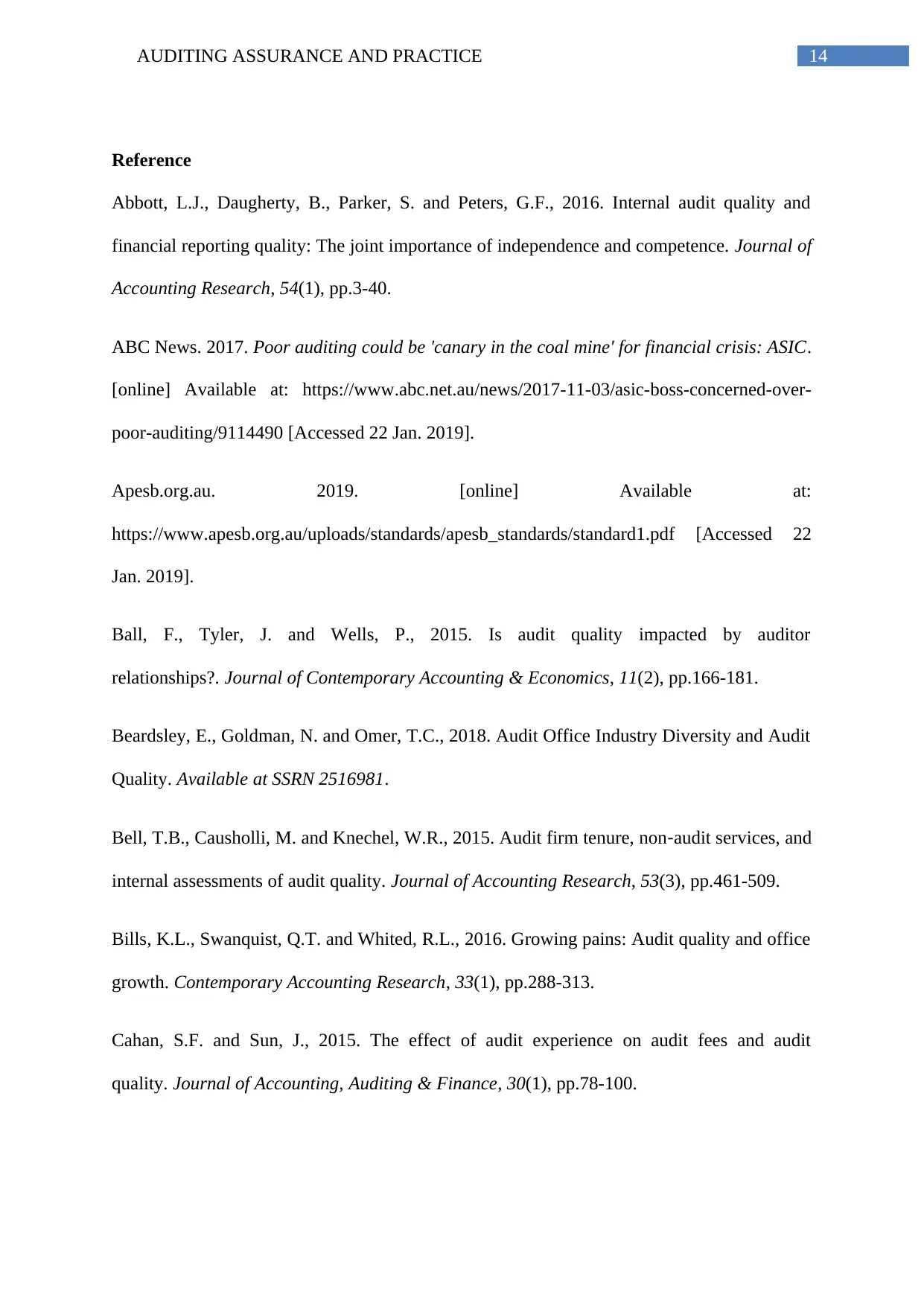
14AUDITING ASSURANCE AND PRACTICE
Reference
Abbott, L.J., Daugherty, B., Parker, S. and Peters, G.F., 2016. Internal audit quality and
financial reporting quality: The joint importance of independence and competence. Journal of
Accounting Research, 54(1), pp.3-40.
ABC News. 2017. Poor auditing could be 'canary in the coal mine' for financial crisis: ASIC.
[online] Available at: https://www.abc.net.au/news/2017-11-03/asic-boss-concerned-over-
poor-auditing/9114490 [Accessed 22 Jan. 2019].
Apesb.org.au. 2019. [online] Available at:
https://www.apesb.org.au/uploads/standards/apesb_standards/standard1.pdf [Accessed 22
Jan. 2019].
Ball, F., Tyler, J. and Wells, P., 2015. Is audit quality impacted by auditor
relationships?. Journal of Contemporary Accounting & Economics, 11(2), pp.166-181.
Beardsley, E., Goldman, N. and Omer, T.C., 2018. Audit Office Industry Diversity and Audit
Quality. Available at SSRN 2516981.
Bell, T.B., Causholli, M. and Knechel, W.R., 2015. Audit firm tenure, non‐audit services, and
internal assessments of audit quality. Journal of Accounting Research, 53(3), pp.461-509.
Bills, K.L., Swanquist, Q.T. and Whited, R.L., 2016. Growing pains: Audit quality and office
growth. Contemporary Accounting Research, 33(1), pp.288-313.
Cahan, S.F. and Sun, J., 2015. The effect of audit experience on audit fees and audit
quality. Journal of Accounting, Auditing & Finance, 30(1), pp.78-100.
Reference
Abbott, L.J., Daugherty, B., Parker, S. and Peters, G.F., 2016. Internal audit quality and
financial reporting quality: The joint importance of independence and competence. Journal of
Accounting Research, 54(1), pp.3-40.
ABC News. 2017. Poor auditing could be 'canary in the coal mine' for financial crisis: ASIC.
[online] Available at: https://www.abc.net.au/news/2017-11-03/asic-boss-concerned-over-
poor-auditing/9114490 [Accessed 22 Jan. 2019].
Apesb.org.au. 2019. [online] Available at:
https://www.apesb.org.au/uploads/standards/apesb_standards/standard1.pdf [Accessed 22
Jan. 2019].
Ball, F., Tyler, J. and Wells, P., 2015. Is audit quality impacted by auditor
relationships?. Journal of Contemporary Accounting & Economics, 11(2), pp.166-181.
Beardsley, E., Goldman, N. and Omer, T.C., 2018. Audit Office Industry Diversity and Audit
Quality. Available at SSRN 2516981.
Bell, T.B., Causholli, M. and Knechel, W.R., 2015. Audit firm tenure, non‐audit services, and
internal assessments of audit quality. Journal of Accounting Research, 53(3), pp.461-509.
Bills, K.L., Swanquist, Q.T. and Whited, R.L., 2016. Growing pains: Audit quality and office
growth. Contemporary Accounting Research, 33(1), pp.288-313.
Cahan, S.F. and Sun, J., 2015. The effect of audit experience on audit fees and audit
quality. Journal of Accounting, Auditing & Finance, 30(1), pp.78-100.
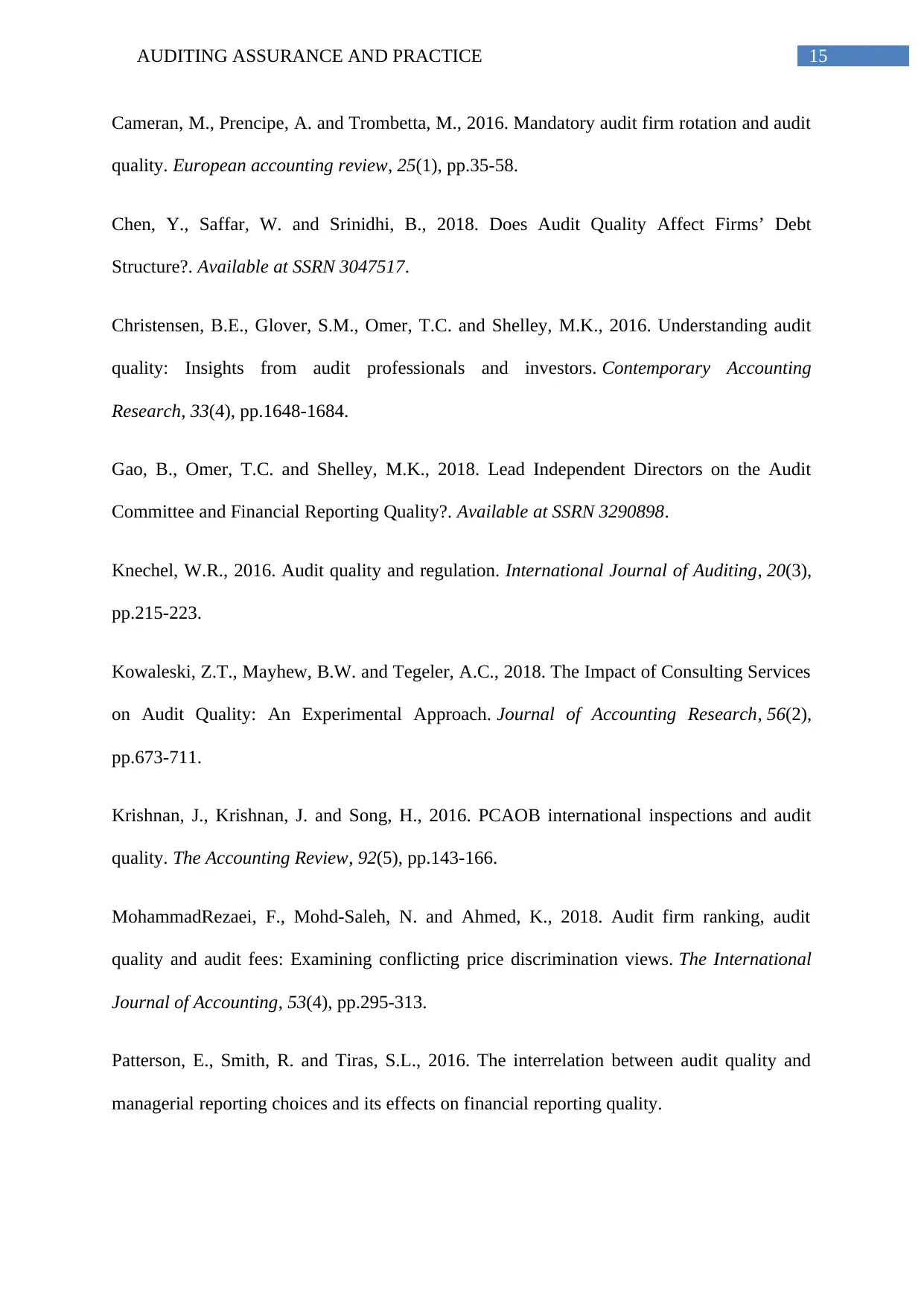
15AUDITING ASSURANCE AND PRACTICE
Cameran, M., Prencipe, A. and Trombetta, M., 2016. Mandatory audit firm rotation and audit
quality. European accounting review, 25(1), pp.35-58.
Chen, Y., Saffar, W. and Srinidhi, B., 2018. Does Audit Quality Affect Firms’ Debt
Structure?. Available at SSRN 3047517.
Christensen, B.E., Glover, S.M., Omer, T.C. and Shelley, M.K., 2016. Understanding audit
quality: Insights from audit professionals and investors. Contemporary Accounting
Research, 33(4), pp.1648-1684.
Gao, B., Omer, T.C. and Shelley, M.K., 2018. Lead Independent Directors on the Audit
Committee and Financial Reporting Quality?. Available at SSRN 3290898.
Knechel, W.R., 2016. Audit quality and regulation. International Journal of Auditing, 20(3),
pp.215-223.
Kowaleski, Z.T., Mayhew, B.W. and Tegeler, A.C., 2018. The Impact of Consulting Services
on Audit Quality: An Experimental Approach. Journal of Accounting Research, 56(2),
pp.673-711.
Krishnan, J., Krishnan, J. and Song, H., 2016. PCAOB international inspections and audit
quality. The Accounting Review, 92(5), pp.143-166.
MohammadRezaei, F., Mohd-Saleh, N. and Ahmed, K., 2018. Audit firm ranking, audit
quality and audit fees: Examining conflicting price discrimination views. The International
Journal of Accounting, 53(4), pp.295-313.
Patterson, E., Smith, R. and Tiras, S.L., 2016. The interrelation between audit quality and
managerial reporting choices and its effects on financial reporting quality.
Cameran, M., Prencipe, A. and Trombetta, M., 2016. Mandatory audit firm rotation and audit
quality. European accounting review, 25(1), pp.35-58.
Chen, Y., Saffar, W. and Srinidhi, B., 2018. Does Audit Quality Affect Firms’ Debt
Structure?. Available at SSRN 3047517.
Christensen, B.E., Glover, S.M., Omer, T.C. and Shelley, M.K., 2016. Understanding audit
quality: Insights from audit professionals and investors. Contemporary Accounting
Research, 33(4), pp.1648-1684.
Gao, B., Omer, T.C. and Shelley, M.K., 2018. Lead Independent Directors on the Audit
Committee and Financial Reporting Quality?. Available at SSRN 3290898.
Knechel, W.R., 2016. Audit quality and regulation. International Journal of Auditing, 20(3),
pp.215-223.
Kowaleski, Z.T., Mayhew, B.W. and Tegeler, A.C., 2018. The Impact of Consulting Services
on Audit Quality: An Experimental Approach. Journal of Accounting Research, 56(2),
pp.673-711.
Krishnan, J., Krishnan, J. and Song, H., 2016. PCAOB international inspections and audit
quality. The Accounting Review, 92(5), pp.143-166.
MohammadRezaei, F., Mohd-Saleh, N. and Ahmed, K., 2018. Audit firm ranking, audit
quality and audit fees: Examining conflicting price discrimination views. The International
Journal of Accounting, 53(4), pp.295-313.
Patterson, E., Smith, R. and Tiras, S.L., 2016. The interrelation between audit quality and
managerial reporting choices and its effects on financial reporting quality.
Secure Best Marks with AI Grader
Need help grading? Try our AI Grader for instant feedback on your assignments.
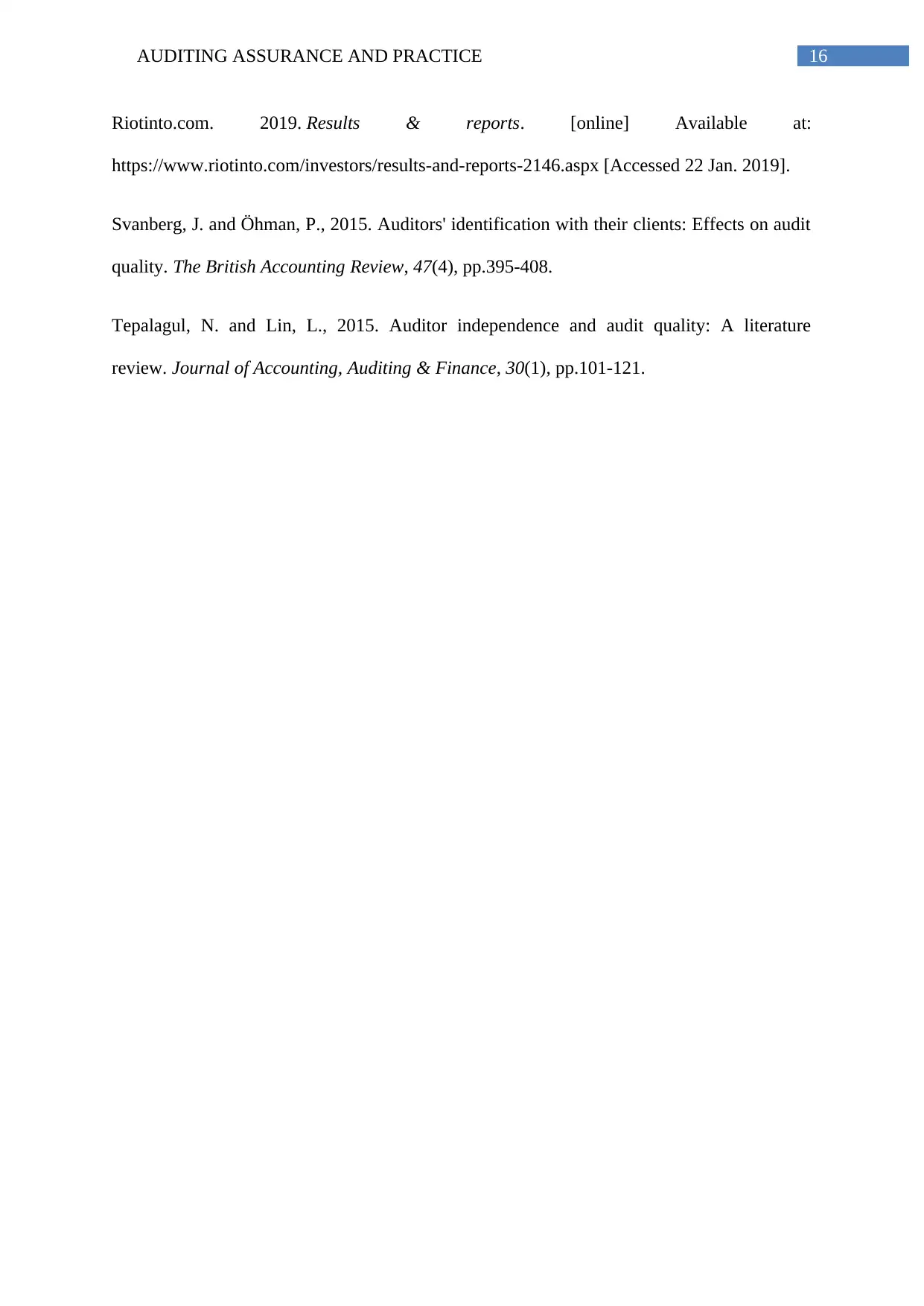
16AUDITING ASSURANCE AND PRACTICE
Riotinto.com. 2019. Results & reports. [online] Available at:
https://www.riotinto.com/investors/results-and-reports-2146.aspx [Accessed 22 Jan. 2019].
Svanberg, J. and Öhman, P., 2015. Auditors' identification with their clients: Effects on audit
quality. The British Accounting Review, 47(4), pp.395-408.
Tepalagul, N. and Lin, L., 2015. Auditor independence and audit quality: A literature
review. Journal of Accounting, Auditing & Finance, 30(1), pp.101-121.
Riotinto.com. 2019. Results & reports. [online] Available at:
https://www.riotinto.com/investors/results-and-reports-2146.aspx [Accessed 22 Jan. 2019].
Svanberg, J. and Öhman, P., 2015. Auditors' identification with their clients: Effects on audit
quality. The British Accounting Review, 47(4), pp.395-408.
Tepalagul, N. and Lin, L., 2015. Auditor independence and audit quality: A literature
review. Journal of Accounting, Auditing & Finance, 30(1), pp.101-121.
1 out of 17
Related Documents
Your All-in-One AI-Powered Toolkit for Academic Success.
+13062052269
info@desklib.com
Available 24*7 on WhatsApp / Email
![[object Object]](/_next/static/media/star-bottom.7253800d.svg)
Unlock your academic potential
© 2024 | Zucol Services PVT LTD | All rights reserved.





